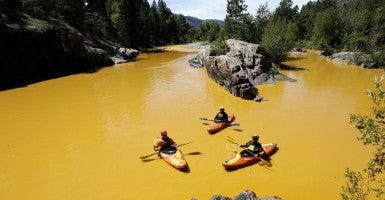The Environmental Protection Agency recently commissioned an analysis of how EPA contractors and officials, on August 5, caused a deluge of 3 million gallons of water containing toxic heavy metals into the Animas River, which serves as a drinking water source for thousands of residents in Colorado and other states. The EPA activity that produced this disaster involved excavations around the Gold King gold mine.
Heritage Foundation scholars criticized the government’s failure to take one step that it assuredly would have pursued had a private party caused the spill: Open a criminal investigation.
The report published by the Department of the Interior Bureau of Reclamation (BOR) buries most of the facts that are relevant to the cause of the spill under 120 pages of superfluous information, while including just enough facts to make it clear that had a private party caused the Animas River spill, it would probably have been criminally prosecuted.
The federal government should investigate the EPA’s conduct or abandon prosecutions of private parties for similar negligent violations of the criminal law.
According to the Bureau of Reclamation report, the EPA’s project leader for the Gold King Mine excavation was unsure of his plans “and wanted an outside independent review.” So he called Bureau of Reclamation supervisory civil engineer and co-author of the Bureau of Reclamation report, Michael J. Gobla, to request a visit to the Gold King Mine site and assessment of the EPA’s excavation plans.
They scheduled Gobla’s on-site review of the plans for August 14, when the project leader would be back from a vacation. But just six days later, on July 29, individuals began excavating debris around the mine portal.
EPA personnel continued excavations on August 4, “to examine conditions close to the mine opening,” and began discussing a new plan “to open the adit”—a horizontal passage leading into a mine for the purpose of access or drainage—with contractors and representatives of the Colorado Division of Reclamation, Mining and Safety (DRMS).
They assumed that they knew where the water levels were inside the mine based on some observations of the site and planned to dig into the mine above that point, thinking they would not disturb the massive amounts of pressurized water within the mine.
Instead of waiting to confirm their plans or even consult with the Bureau of Reclamation as the project leader had scheduled, contractors began excavating based on those unchecked assumptions on August 5. A backhoe operator hit a spring and, according to the Bureau of Reclamation report, “[w]ithin moments, the ‘spring’ began spurting upward,” beginning the more than 3-million-gallon flood of acid mine water into the Animas River.
The Bureau of Reclamation had estimated the water level inside the mine to be significantly higher than the levels assumed by the EPA and Colorado Division of Reclamation, Mining and Safety. Had EPA personnel waited for an independent review of their plans, they might have changed them and prevented the blowout.
Private parties have been held criminally liable for similar conduct. Consider Temple Inland, sentenced to two years’ probation and ordered to pay a total criminal penalty of $3.3 million for negligently allowing a piece of equipment called an “evaporator” to become clogged, fill up with water, and eventually discharge into a nearby river. In both the Temple Inland and Animas River discharges, individuals failed to check how full an object was—one an “evaporator,” the other a mine—and a discharge occurred due to conduct based on that failure. Temple Inland was prosecuted and made to pay money to organizations of the EPA’s choosing. The EPA employees, agents, and officials were not.
EPA officials made a second mistake: They did not, according to the Bureau of Reclamation report, use “a drill rig to bore into the mine from above to directly determine the level of the mine pool prior to excavating backfill at the portal,” as they had successfully done before. Had they used a drill rig at the Gold King Mine, the Bureau of Reclamation concluded, “the plan to open the mine would have been revised, and the blowout would not have occurred.”
There are many more facts that the Bureau of Reclamation report fails to mention, such as who specifically did what and why. But a close reading of the Bureau of Reclamation’s 132-page report reveals that the EPA failed to consider the necessary engineering factors involved in the opening of the Gold King Mine.
So far, the executive branch has not met the promise its representatives made in a public comment session at a local Colorado high school auditorium to “hold [itself] to the same standards that [it] would anyone that would have created this situation”—in other words, to treat government officials in the same way as it would have treated private parties responsible for the same conduct.
The House Committee on Natural Resources held a hearing on Dec. 9 to review the Animas River Spill and the Department of the Interior’s role. As Heritage scholars explain in a publication on the Bureau of Reclamation’s report, Congress should continue to ask the EPA, the Justice Department, and the Department of the Interior why the federal government discriminates in favor of government employees and against private parties.






























